![]()
St. Gregory's Works, High Street Longton
NOTE: In 1883 there was another (unrelated) St. Gregory's works built - click for information -
|
"The former St. Gregory Works on the north side of High Street is said to have been established by George Barnes in 1794, and it was still in his hands c. 1800.
It is probably identifiable with the works in Hog's Lane (now Sutherland Road) held by him in 1823.
Apparently in the hands of Chesworth and Blood in 1824, it was held by Wood and Blood by 1827 and by Beardmore and Birks from 1830 or 1831 until 1843. It seems then to have passed to Sampson Beardmore who in 1850 was succeeded by George Townsend.
Tams and Lowe took over the works in 1864 and were still in possession in 1874.In 1874 or 1875 William Lowe succeeded,
building the Sydney Works to the rear in Sutherland Road in 1879 for the china department.
The firm remained in operation until c. 1930; the St. Gregory Works has been demolished and the Sydney Works is now
(1963) a textile factory" "St. Gregory s Pottery. These works, in High Street, were established in 1794 by Mr. G. Barnes, and were successively held by him and his partner Mr. Wood (under the style of Barnes & Wood), by Messrs. Wood & Blood, Mr. Chesworth ; Messrs. Beardmore & Birks, and Mr. G. Townsend, from whom they passed in 1864 to Messrs. Tarns & Lowe; they now belong to Mr. William Lowe alone. The goods produced comprise all the usual varieties of articles in useful ordinary earthenware, and in china of an average quality. In the former, dinner, tea, toilet, and other services, &c., are made in white, sponged, printed, ground-laid, and gilt varieties; in the latter only the ordinary common classes are made, principally for the home trade. The quality of the body is firm and good, and the mosaic jugs and tea-pots, mounted and otherwise, are well formed and decorated. In these and in the reeded turquoise tea-pots, &c., the ground colours are clear and even. The usual mark in the common willow pattern is a garter, with the words STAFFORDSHIRE IMPROVED, enclosing the name of the pattern and the Staffordshire knot; the ribbon is surmounted by a crown, and beneath are the initials of the firm, T. & L."
The Ceramic Art of Great Britain Vol II, 1878;
Llewellynn Jewitt |
| From | To | Occupier | Comments |
| 1794 | 1823 | George Barnes |
The former St. Gregory Works on the north side of High Street,
Longton was established by George Barnes in 1794. It is probably identifiable with the works in Hog's Lane (now Sutherland Road) held by him in 1823. George & William Barnes were in partnership together. William left in 1804. George Barnes was in partnership with a Mr. Wood (as Barnes & Wood) |
| 1824 | Chesworth and Blood | The details of Chesworth / Chesworth & Blood are uncertain | |
| 1827 | Wood,
Chesswas & Co Wood, Ratcliffe & Blood |
The
partners were Stephen Wood, Thomas Edensor Chesswas, William Ratcliffe and Thomas Blood. Chesswas left this partnership at the end of April 1827. |
|
| 1827 | 1829 | Wood and Blood | In July 1827 Ratcliffe left the business which was continued by Wood and Blood. |
| 1830 | 1843 | Beardmore and Birks | |
| 1843 | 1850 | Sampson Beardmore | It was Sampson Beardmore who called the works "Old Established Pottery" |
| 1850 | 1864 | George Townsend | The
works were recorded in trade directories as 17 High Street (which was
renamed Uttoxeter Road in the early 1950s) Townsend continued the name "Old Established Pottery" From around 1862 Townsend operated from Chadwick Street and Stafford Street, Longton. |
| 1864 | 1874 | Tams and Lowe | Trade directory for 1868 "Tams & Lowe, High Street, Longton—Lustre, Egyptian Black, Turquoise, Cain, Sage, and Printed Ware, Stone Mortars, etc." |
| 1874 | 1930 | William Lowe | William Lowe built the Sydney Works to the rear in Sutherland Road in 1879 for the china department. |
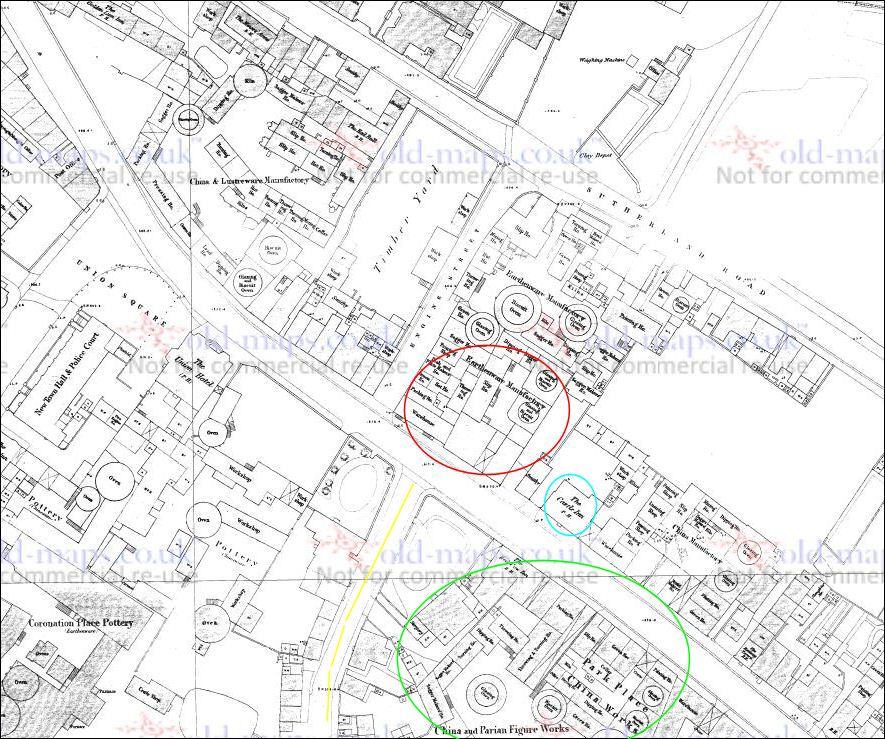
1851 map showing the location
of St. Gregory's Pottery In red) on the High Street, Longton
In the early 1950s the High Street was
renamed Uttoxeter Road
Red = St. Gregory's Pottery
Blue = Castle Inn
Green = Park Place Works
Yellow = Chadwick Street
Source: old-maps.co.uk
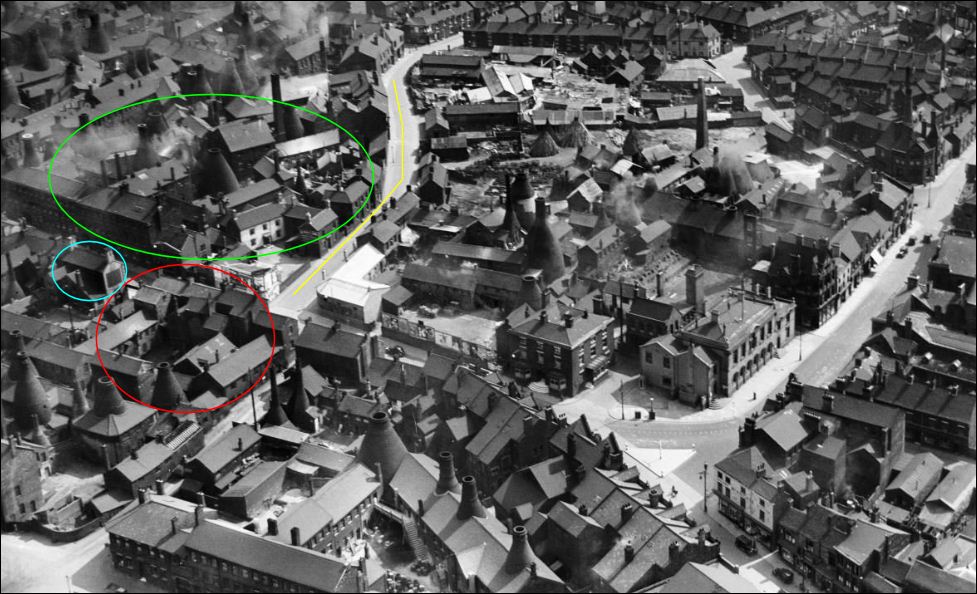
1937 showing Union Square and
Commerce Street to the right and to the left Park Place Works on the High Street
Red = St. Gregory's Pottery
Blue = Castle Inn
Green = Park Place Works
Yellow = Chadwick Street
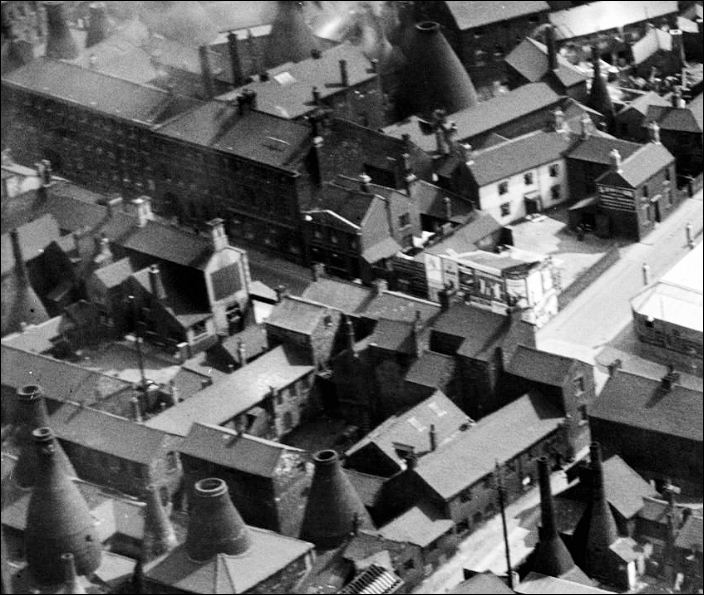
Source: Britain from Above
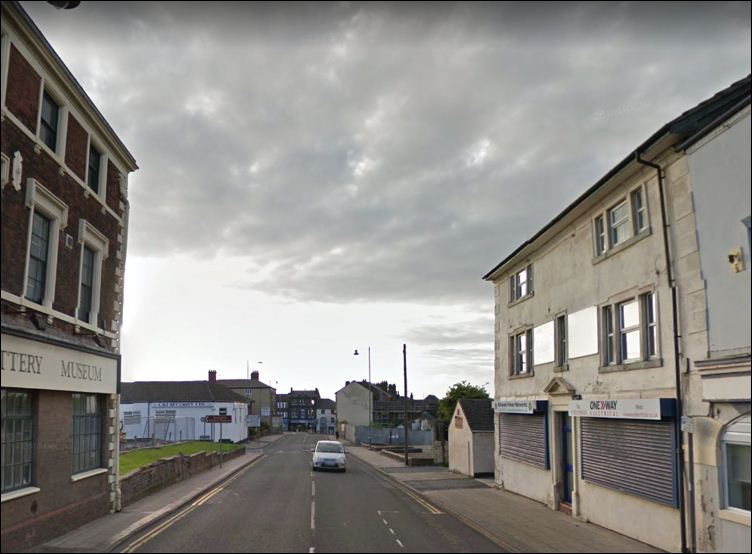
view down Uttoxeter Road (was
the High Street)
on the left is the Gladstone
Pottery Museum (was Park Place Works)
on the right is the building which was the Castle Inn and just past that
is the area where the St. Gregory's Pottery Works was located (now demolished)
Google Street View 2015
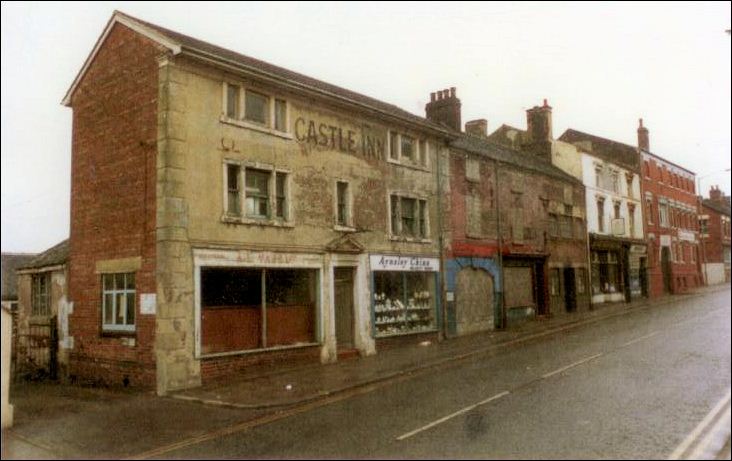
view up Uttoxeter Road (was the
High Street) showing the Castle Inn
c.1980
Courtesy: Mervyn Edwards -
'Longton Through Time'
Questions, comments, contributions? email: Steve Birks